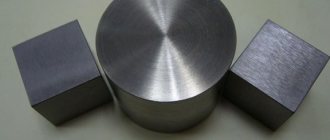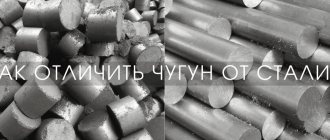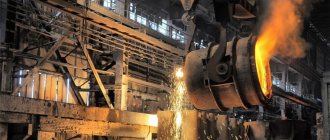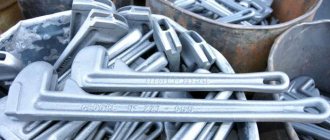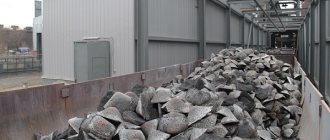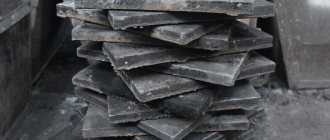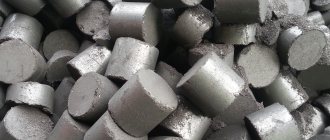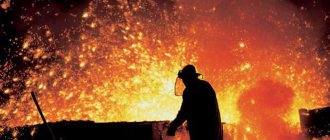Mining and processing plants
The main raw material used in the production of cast iron is iron ore. It is mined in quarries in different places in our country. As you know, mined ore contains a large amount of various types of impurities. Of course, it cannot be used for melting cast iron in such a “raw” form. Therefore, at the first stage, it goes to special enterprises - mining and processing plants. Here waste rocks are removed from it and crushed. Then the clean ore is loaded into train cars and sent to metallurgical plants.
Agglomeration process
In fact, we’ll look at how cast iron is produced below. Now let's talk about how ore is prepared for smelting directly at metallurgical plants.
If ordinary crushed material is used for smelting, the productivity of the blast furnace will drop sharply. The fact is that such a charge has a low degree of gas permeability. Therefore, before loading into the blast furnace, ore must undergo an agglomeration process.
This procedure is carried out in specialized workshops of metallurgical plants and is a process of sintering rock into pieces of a certain size most suitable for smelting cast iron. Adhesion occurs at a high temperature sufficient to easily melt the surface of the charge particles. As a result, the latter simply stick together to form pieces. In this case, the ore is first mixed with coal. As a result of the combustion of the latter, the temperature necessary for obtaining pieces is achieved. The agglomeration process is stimulated by passing air flows through the layer of ore with coal (from top to bottom).
Not only ore can be used to obtain sinter. Sometimes it is also made from small pieces of iron. Its alloy with what substance makes it possible to obtain cast iron will be discussed below. Of course, it is not pig iron that is used to produce this metal. Regular scrap metal is melted down into cast iron.
What happens in the oven
So, let's look at how pig iron is produced in a blast furnace. The inside of a stove of this design is lined with brick. The principle of its operation is relatively simple. In the production of cast iron, in addition to sinter, coke, lime and flux are used. A mixture of these materials is prepared in a certain proportion. This is what is called a blast furnace charge. It is poured into special lifts and raised to the very top of the furnace.
In order for coke to ignite, a large amount of air enriched with oxygen is necessary. It is fed into the blast furnace from below, through special openings called tuyeres. It is blown into the furnace under very high pressure. This is necessary so that air penetrates through the layer of charge supplied from above. In this case, the flow is preheated to 600-800 degrees, otherwise the temperature inside the furnace will drop.
The cast iron obtained by straightening the charge flows down and is released out through a special hole called a taphole at intervals of approximately once every 40 minutes. Next, it is poured into large-capacity bowls and transported to steelmaking shops.
Story
The technology for making cast iron came to us from China, where cast iron money circulated back in the 10th century AD. The descendants of the Mongols already prepared boilers from this alloy in the 13th century. On the battlefields of the Hundred Years' War, artillery pieces and ammunition cast from this solid solution were used for the first time. In Russia, its widespread use in the manufacture of weapons was established in the 16th century after the appearance of the blast furnace. In this regard, the Ural Iron Foundry was built in 1701, which became the beginning of a folk craft called “Kasli casting”.
Since the 18th century, Great Britain has been the world's leading iron producer. Thanks to Wilkinson's new technology, by the mid-19th century this country produced half the world's total.
Manufacturing technology did not stand still, which allowed the United States to take the lead at the end of the 19th century.
At that time, rails, water and sewer pipes, fireplaces, and such complex engineering structures as bridges began to be made from this alloy.
Reduction and carburization of iron in a furnace
All blast furnaces operate on the counterflow principle. At the same time, the following chemical processes alternately occur in them:
- Iron recovery. This process occurs sequentially and looks like this: Fe2O3 - Fe3O4 - FeO - Fe. The reducing agent in this case is carbon monoxide (CO), formed by the interaction of CO2 with hot coke, as well as solid carbon of the latter.
- Carbonization of iron. The reaction in this case looks like this: 3Fe + 2CO = Fe3C + CO2 + Q. Fe3C carbide easily mixes with solid iron, resulting in the formation of an alloy of the latter with carbon. Flowing down, it washes the pieces of coke and carbonizes even more. In addition, substances such as manganese, sulfur, silicon, etc. dissolve in it.
Thus, it becomes clear that blast furnace metal is an alloy of iron with what substance. Cast iron can be obtained simply by carburizing the charge melt.
Restoring other items
Mn, silicon, sulfur and phosphorus enter the blast furnace along with the charge in the form of various chemical compounds. Higher manganese oxides are reduced to MnO according to approximately the same principle as iron: MnO2 - Mn2O3 - Mn3O4 - MnO. Pure manganese is released as follows: MnO + C = Mn + CO - Q. Silicon enters the furnace in the form of silica SiO2. Its reduction occurs by the reaction SiO2 + 2C = Si + 2CO - Q.
Phosphorus is reduced by hydrogen, solid carbon and CO and, unfortunately, goes into cast iron almost completely. This element deteriorates the blast furnace iron alloy. Allows you to obtain good quality cast iron with silica present in the charge, as well as higher manganese oxides. In some cases, Mn is added to the blast furnace on purpose. This produces a special type of cast iron - manganese.
Wax removal
The question of how to obtain cast iron of good quality also comes down to cleaning it from this undesirable element. Sulfur is the main harmful impurity that significantly worsens the properties of the final smelting product. Its main quantity is contained in coke. Sulfur is removed by increasing the lime (CaO) content in the charge and increasing the temperature in the furnace. The reaction in this case looks like this: FeS + CaO = FeO + CaO + Q. Other methods can be used to reduce the percentage of sulfur content in cast iron. For example, sometimes the already smelted material is processed in a discharge chute or a bowl of soda. In this case, the removal of sulfur occurs as a result of the reaction FeS + NaCO3 = FeO + Na2S + CO2.
Features of caring for cast iron cookware
After any type of cleaning, measures must be taken to create a protective layer on the cast iron to prevent corrosion in the future:
- turn on the oven at 180 degrees, warm it up;
- grease the frying pan with oil (any oil except olive oil), applying a thin layer;
- place the product in the oven, bottom up, leave for 60 minutes;
- turn off the cabinet, do not take out utensils for another hour;
- Remove the pan, rinse, wipe dry, and put away for storage.
Cast iron should always remain a little greasy - this will allow it to maintain protection against corrosion for a long time. In the future, you should follow these care tips:
- Always wait for the product to cool down and only then start washing it;
- after each wash, lubricate the item with vegetable oil and heat for 1-2 minutes;
- do not leave the pan with ready-made liquid food for a long time - after cooking, pour it into another container;
- do not use aggressive detergents, brushes, or abrasives on a regular basis, they wash off the protective layer and the cast iron rusts faster;
- to remove burnt food, soak the dishes in warm water, then easily remove the remains with a washcloth;
- do not forget to use the dishes regularly so that they do not stand idle;
- do not wash in the dishwasher;
- Do not cook acidic food, which corrodes the protective layer.
High-quality care of cast iron will keep the product in excellent condition, eliminate the appearance of rust, while maintaining its non-stick properties and ability to retain heat.
Sources
- https://jgems.ru/metally/chugun
- https://stroyres.net/metallicheskie/vidyi/chyornyie/chugun/ponyatie-osobennosti.html
- https://metallicheckiy-portal.ru/articles/chermet/raznoe/chto-takoe-chugun-sostav-i-soderzhanie-ugleroda-v-splave/
- https://elton-zoloto.ru/raznoe/skolko-procentov-ugleroda-imeetsja-v-sostave-chuguna.html
- https://lux-stahl.ru/metally-i-splavy/izbytok-alyuminiya-v-chugunah-vyglyadit-kak.html
- https://ometalledo.ru/soderzhanie-ugleroda-v-chugune-i-stali.html
- https://www.syl.ru/article/304510/chto-takoe-chugun-svoystva-sostav-poluchenie-i-primenenie
- https://sakhkor.ru/materialy/vidy-chuguna.html
- https://morflot.su/procentnoe-soderzhanie-ugleroda-v-chugune/
- https://metallvsegda.ru/poleznoe/chto-takoe-chugun-sostav-i-soderzhanie-ugleroda-v.html
Slag formation
Thus, we have found out how cast iron is produced. However, when this material is smelted, another product is obtained that is widely used in the national economy. When melting 1 ton of cast iron, 0.6 tons of slag comes out. The fact is that even refined iron ore contains a fairly large amount of clay. Coke also contains ash. To remove these unnecessary elements, among other things, fluxes (calcium and magnesium carbonates) are added to the charge. During the smelting process, they enter into a chemical reaction with various types of impurities, resulting in the formation of slag. It is an aluminosilicate or silicate melt.
The density of slag is less than that of liquid cast iron. Therefore, during the melting process it is located underneath. It is removed periodically through a separate taphole, called a slag taphole. This by-product of iron foundries is used mainly for the production of cement and building blocks as a filler.
Types of cast iron
As you can see, the question of how to get cast iron in a blast furnace is relatively simple. Ultimately, however, the furnace may leave a material that is slightly different in chemical composition and physical properties. All cast irons are mainly divided into two varieties: pig iron (white) and foundry cast iron (gray). The first type is used as a raw material in the production of steel. Foundry is used to produce various types of cast iron products, which are in good demand on the market.
Literature
| cast iron in Wiktionary |
- Yu. M. Lakhtin, V. P. Leontyeva.
Materials Science. - M.: Mechanical Engineering, 1990. - 528 p. - Physics and chemistry of solid state No. 4 2014 (vol. 15) (ISSN1729-4428)
| Alloys | Akmonital | Aluminum bronze (CuAl) | Bronze (CuSn) | Ducat gold | Kolyvan copper (CuAuAg) | Brass (CuZn) | Copper-nickel alloy (CuNi) | Cupronickel (CuNiFeMn) | Nickel silver, nickel silver (CuZnNi) | Stainless steel (FeCrNi) | Nickel Bronze (CuSnNi) | Nickel-iron alloy (NiFe) | Nickel-zinc alloy (NiZn) | Potin | Northern gold (CuAlZnSn) | Steel (Fe) | Sterling (AgCu) | Tompak (CuZn) | Chrome steel (FeCr) | Cast iron (Fe) | Electrum, electron, electrum (AuAg) |
| Groups of coins | Bimetal | Billboard | Bronze | Copper | Iron | Gold | Palladium | Platinum | Silver | Siberian |
| Metal groups | Coin group (copper subgroup) | Noble metals | Platinum group |
| see also | Paper money | Polymer money | Money paper | Leather rubles | Stamps-money | Coinage | Notgeld | Symbols of precious metals |
White cast iron
The share of this type of metal smelted in blast furnaces is 75-80%. The main properties of such cast iron are: high hardness, brittleness and wear resistance. It usually contains more manganese and sulfur than foundry. White cast iron is difficult to process. It is impossible to use conventional cutting tools of modern machines to make any products from it. But steel is obtained from cast iron of this type quite simply. Depending on the method of further smelting, pig furnace metal is divided into three classes: open-hearth (M), Bessemer (B) and Thomas (T).
Interesting Facts
- According to Professor Marienbach, cast iron got its name from the Chinese word “zhugun”, which means “foundry worker”.
- Cast iron cookware has long been used around the world and is very convenient for preparing various types of food.
- An integral attribute of Russian folk tales is the oven, in which, in a cast iron pot - a vessel of a certain shape and cast from a given alloy, the heroes cooked the main dish - jacket potatoes.
- The best pancakes are made in a cast iron skillet.
- Before the advent of electric irons, housewives used heavy cast iron irons with perfectly smooth soles, heating them until red hot over a fire source.
- The next stage was coal cast-iron irons, whose design resembled small stoves. To heat them, birch charcoal was placed inside. This iron even had a pipe to obtain the necessary traction.
- The sewer manholes for inspection wells known to us from childhood were round in shape, cast from cast iron and were first made one hundred and fifty years ago.
- Pig iron production worldwide in 2015 amounted to more than 898 million tons, which is 3% less than in 2008.
Cast iron
Carbon in this material is mainly contained in the form of free graphite, which contains silicon. It is supplied for the manufacture of cast iron products in the form of pigs. This material is marked with the letter “L” and numbers from “1” to “6”, depending on its purpose. There is also cast iron refined by magnesium, marked with the letters “LR”.
Well, we hope that we have sufficiently answered the question of what alloy of iron with what substance makes it possible to obtain cast iron. This is ordinary carbon that replaces the oxygen contained in the ore in the blast furnace. The main properties of cast iron depend on the amount of impurities included in its composition: manganese, phosphorus, silicon and sulfur.
Scope of application
Malleable cast iron has found its application in mechanical engineering for the production of machine tools, individual car parts, structures and mechanisms used in railway transport, etc.
Most often, ferrite castings are used, which are somewhat cheaper than all others. Perlite castings are used for the manufacture of parts that are used for products and assemblies operating under increased loads.
Malleable cast iron is used to produce castings with a thin wall; its size can range from 3 to 40 mm.
